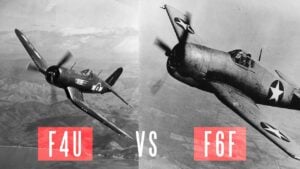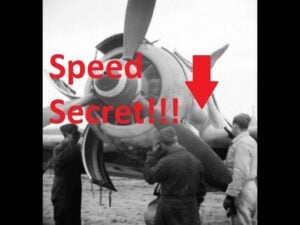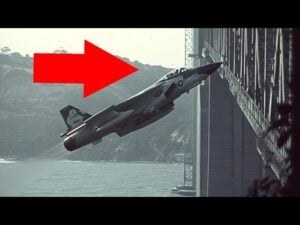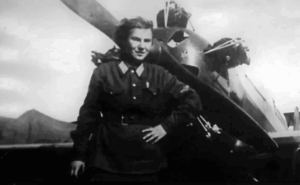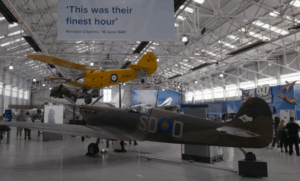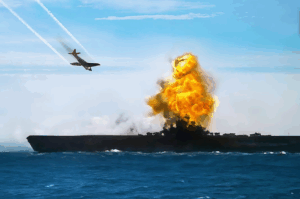U.S. WWII Experimental Super Planes

IHYLS / YouTube
During World War II, aircraft innovation was essential to gaining the upper hand in air combat. Beyond the well-known fighters and bombers, there was an elite set of experimental planes that showcased advanced engineering and new ideas, testing the boundaries of what was possible. These “super planes” never became mainstream but were crafted for missions that regular planes couldn’t handle. The following five U.S. experimental aircraft represent the cutting-edge attempts to create machines capable of changing the course of aerial warfare. Each had unique features and pushed the limits of design and speed.
1. Lockheed XP-58 Chain Lightning

The Lockheed XP-58 was an ambitious attempt to design a long-range escort fighter for U.S. bombers. Built as an extension of the Lockheed P-38 Lightning, it featured a twin-boom design similar to its predecessor but larger and more powerful. The XP-58 was equipped with two Allison V-3420 engines, giving it high speed and excellent range. Its armament was originally designed to include large-caliber machine guns and even cannons, aiming to counter the heavily armed bombers that Axis forces might deploy.
The XP-58 was intended for high-altitude performance and power but encountered several challenges during testing. The complex engine design proved unreliable, and issues with stability made the plane difficult to maneuver. Although these difficulties slowed its development, the XP-58 demonstrated the U.S. commitment to creating an escort fighter with extensive range. Despite never entering full production, the XP-58 contributed valuable knowledge that informed later American aircraft designs.
2. Hughes XF-11

The Hughes XF-11 was an experimental reconnaissance aircraft developed to gather intelligence from enemy territory. Conceived by Howard Hughes and his team, this twin-engine plane was designed with a unique feature: counter-rotating propellers that would help increase stability and speed. This design aimed to ensure smooth handling and maintain the stealth necessary for high-risk reconnaissance missions.
Despite its innovative design, the XF-11 project faced serious setbacks. During an initial test flight in 1946, Hughes himself piloted the XF-11 in a flight that ended in a crash due to a propeller malfunction, leading to significant injuries for Hughes and damage to the plane. The U.S. Army Air Forces ultimately decided to cancel further development due to persistent technical issues and high production costs. Even though the XF-11 never reached operational status, it symbolized an early attempt to create a long-range, high-speed reconnaissance plane.
3. Northrop XP-79 Flying Ram

The Northrop XP-79 was one of the most unusual aircraft developed during World War II, designed as a flying wing with unique features meant for aerial combat. Created by Jack Northrop, this plane used a magnesium alloy construction to keep it light and fast. The XP-79 was intended as an interceptor that could ram enemy bombers if necessary, earning it the nickname “Flying Ram.” Unlike traditional aircraft, the XP-79’s cockpit was positioned at the front of the wing, giving the pilot enhanced visibility and the impression of “flying the wing” itself.
Powered initially by two rocket engines, the XP-79 faced significant obstacles. Early tests showed that the experimental propulsion system was too unreliable. After switching to jet engines, further testing revealed handling issues, and tragically, the project was scrapped following a fatal crash in 1945. Although it was never deployed in combat, the XP-79’s radical flying wing design influenced later aircraft, including the B-2 stealth bomber, making it a crucial step in aviation experimentation.
4. Boeing XB-15

The Boeing XB-15 was developed as a heavy bomber with an emphasis on long-range missions. Designed in the 1930s as part of the U.S. Army Air Corps’ efforts to create strategic bombers, the XB-15 was massive, with a wingspan over 149 feet and the capability to carry significant bomb loads over distances up to 5,130 miles. This range was impressive for its time, and its mission profile was geared toward reaching targets deep within enemy territory.
The XB-15’s size made it a formidable presence in the sky, but it was also slow, which made it vulnerable to enemy fighters. Though it was initially intended for high-altitude bombing, limitations in speed and maneuverability prevented it from fulfilling this role effectively. Eventually, the XB-15 was repurposed as a cargo and transport plane, helping with wartime supply efforts across the globe. Its design lessons and technical insights informed the later development of the iconic B-17 and B-29 bombers, underscoring its role in the evolution of American strategic bombers.
5. Republic XP-72 Super Thunderbolt

The Republic XP-72 was developed as an upgraded version of the famous P-47 Thunderbolt, known for its rugged build and powerful performance. The XP-72 sought to go beyond the capabilities of the P-47, with a more powerful Pratt & Whitney R-4360 engine that allowed it to reach speeds exceeding 480 miles per hour. Equipped with advanced propeller technology and designed with heavy armament, the XP-72 was intended to be both a high-speed interceptor and ground-attack aircraft.
The XP-72 was meant to counter high-speed German jet fighters that posed a threat to Allied bombers. Although it showed remarkable performance during testing, the introduction of jet-powered fighters reduced the need for piston-engine interceptors like the XP-72. As a result, only two prototypes were built before the project was canceled. Nonetheless, the XP-72 represented the peak of piston-engine fighter development and showcased the U.S. determination to produce fast, powerful planes capable of holding their own in the face of evolving threats.














